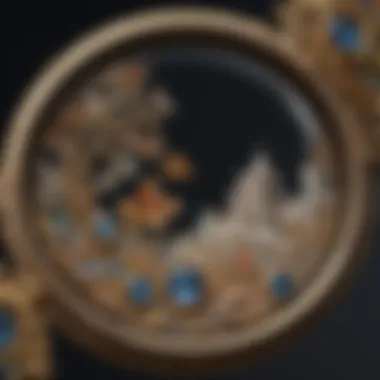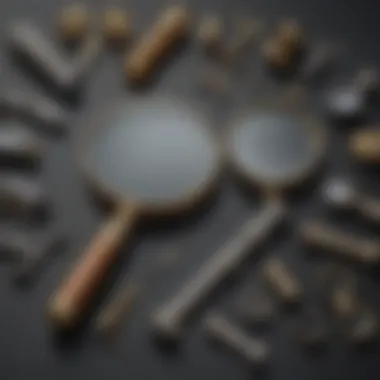Maximizing Jewelry Evaluation with a Magnifying Glass


Intro
Magnifying glasses are indispensable tools for anyone seeking to deeply understand and appreciate the qualities of jewelry. This instrument aids in revealing intricate details that are often overlooked by the naked eye. Their role in jewelry assessment cannot be overstated, marrying function and clarity in collectors' endeavors. The following sections will delve into the various aspects of using a magnifying glass in jewelry evaluations, enhancing the experience for both novice and experienced collectors alike.
Understanding Jewelry Evaluation
To properly assess jewelry, one must familiarize themselves with the fundamental characteristics of the pieces in focus. The types of materials used, the craftsmanship involved, and possible flaws play critical roles. With the aid of magnifying tools, collectors can take steps toward making informed purchasing decisions.
When assessing jewelry, consider investigating various components: the gemstone's cut, clarity, and color; the metal's composition and karat; and the overall craftsmanship. Each factor contributes significantly to both the aesthetic appeal and the value of the piece.
Types of Magnifying Glasses
The market presents numerous magnification options adequate for jewelry assessment:
- Traditional Magnifying Loupe: Often used by jewelers, this portable device typically offers a magnification range of 10x to 20x.
- Headband Magnifier: This hands-free option is perfect for extended use, as wearers can switch focus without sweat or fatigue.
- Jewelry Inspection Microscope: Suitable for those requiring a deeper and more detailed analysis, some microscopes can offer up to 50x magnification or more.
Selecting the type best suited for your requirements will vastly improve the experience of assessing intricate details in your jewelry collection. Pay attention to ergonomic features, magnification power, and lens quality for clarity.
Essential Features to Seek
Proper assessment demands both clarity and convenience. Features to consider when choosing a magnifying glass include:
- Lens Quality: A high-quality lens reduces distortion and enhances clarity, allowing collectors to see fine details without compromise.
- Light Source: Integrated lighting can be beneficial, helping to illuminate hidden features effectively during appraisals.
- Portability: Compact designs facilitate easy transport, ideal for collectors on the go.
These features ensure thorough inspections to affirm or scrutinize the quality and nature of various pieces.
Practical Tips for Effective Usage
Maximize the effectiveness of your magnifying glass engagement with these insights:
- Choose a Suitable Environment: Ensure good lighting and a stable working space to improve visibility.
- Hold Steady: Maintain a steady hand or support for the piece while inspecting areas of interest directly, focusing on one area at a time.
- Compare Multiple Pieces: Utilize the magnifying glass on several similar pieces to identify nuances between variations effortlessly.
Such practical guidance promotes thorough attention to detail, essential for successful jewelry appraisal.
Accurate evaluation directly correlates to an informed buying decision. Do not avoid investing time in mastering your magnifying tool.
Epilogue
Using a magnifying glass offers a gateway into the meticulous world of jewelry assessment. From understanding what toInvestigate to selecting appropriate tools tailored to your needs, this guide lays a groundwork for every collector's endeavors to appreciate jewelry art better. As you explore the available options and techniques, you will enhance your knowledge, enriching the jewelry collection experience.
Intro to Magnifying Glasses in Jewelry Appraisal
Jewelry appraisal requires scrutiny and precision, where details define value and quality. The introduction of magnifying glasses engages collectors in a closer examination of jewelry pieces. Understanding this tool is essential, as it enhances one's ability to discern features that the naked eye might miss. From assessing gems to scrutinizing craftsmanship, a magnifying glass reveals nuances critical during evaluation.
The process is not just analytical; it's an exploration that deepens appreciation for both aesthetics and quality. Collectors seeking to maximize their investment or passion will benefit immensely from utilizing these tools.
Purpose of a Magnifying Glass in Jewelry Inspection
Magnifying glasses serve multiple purposes when it comes to jewelry inspection. Their primary role is to magnify details, allowing collectors to examine characteristics of stones and metals minutely. Here are key purposes:
- Reveal intricate patterns in cut gems.
- Identify inclusions within stones, which can affect value.
- Examine hallmarks and markings on metal to confirm authenticity.
The correct magnification empowers collectors to perform due diligence in their assessments. Specific examples, such as viewing a diamond's facets or noticing the unique signature on sterling silver pieces, underline the necessity of using a quality magnifying glass in jewelry assessments.
Importance of Accurate Evaluation
Accurate evaluation holds great significance in the world of jewelry collection. Missed details may lead to faulty judgments, impacting investment decisions. A magnifying glass ensures collectors have enough information to make informed choices. Details often understated can elevate a piece’s rarity and worth.
Some points to note:


- Value Realization: Knowledge gleaned from inspections can aid in showcasing true value during sales or purchases.
- Quality Verification: Enhancing awareness of counterfeit products helps uphold quality standards in one’s collection.
- Collector Confidence: Knowing you can analyze jewelry enhances trust in your decisions.
Utilizing a magnifying glass transcends mere inspection. It fosters informed decision-making and brings to light information that shapes the narrative surrounding a jewelry piece. The value derived through cautious assessment reflects not just in the marketplace but also in personal satisfaction as a jewelry enthusiast.
Types of Magnifying Glasses
Understanding the different types of magnifying glasses is vital for anyone serious about jewelry appraisal. Each type has its unique features and benefits, making them suitable for specific tasks or preferences. Knowing which one to use can significantly impact the quality of your insights into a piece of jewelry.
Handheld Magnifiers
Handheld magnifiers are some of the most common tools among collectors and jewelers. Their portability is a significant advantage, allowing you to inspect jewelry easily and without restrictions. For example, when evaluating loose stones or intricate designs, these magnifiers provide the flexibility that more stationary options may lack.
One primary characteristic of handheld magnifiers is their variety in magnification power—some can go as high as 10x, which is sufficient for most details. Additionally, they are typically designed with comfortable grips to enhance usability during longer sessions. For non-native speakers, don't forget that careful wrist positioning is important to avoid fatigue.
Taking the time to weigh options will ensure that you find a handheld magnifier that complements your specific appraisal methods. Investing in one often yields quick results, making it easier to spot features such as inclusions or craftsmanship flaws while on the go.
Tripod Magnifiers
Tripod magnifiers stand out by offering superior stability compared to handheld variants. They can be set on a table or surface, allowing continuous focus on the jewelry piece without tiring your arms. This is especially crucial when engaged in detailed assessments or during multiple evaluations.
A significant feature of tripod magnifiers is their adjustability, enabling users to modify the height and angle for the best view. Moreover, with built-in illumination, it ensures that sufficient light enhances visibility of minute details embedded in the jewelry. It's an important point; prior experience shows that consistent lighting enhances focus and precision.
Nevertheless, prospective users must consider the space required for these setups, as not every inspection area lends itself to large, stationary items. Therefore, choose a tripod magnifier wisely based on your storage and operational needs. They can offer unmatched precision in filtering noise within data evaluation.
Loupes: A Specialized Variation
Loupes represent a specialized class of magnifying glass, commonly associated with gem and jewelry professionals. Their distinctive rounded design and particular magnification capabilities, often reaching 20-30x, make them indispensable in the jewelry assessment landscape.
Loupes are most suitable when in-depth examination is necessary, like inspecting pearls for luster or gemstones to understand cut precision. Additionally, they are typically compact, allowing easy portability and use in various locations such as gem shows or exhibitions—a practical advantage that many professional jewelers capitalize on.
To maximize their potential, applying proper technique when looking through a loupe is essential. As all assessment requires both skill and focus, practice enables users to achieve more significant results while minimizing distractions. This nuanced approach ensures that finer detail is not missed, ultimately leading to purchasing decisions that are sounder and more informed.
In concluding this section, it is essential to understand that the type of magnifier chosen can deeply influence the jewelry evaluation process, shaping the expertise one brings to the table in both personal collections and professional assessments.
Essential Features of Magnifying Glasses
Understanding the essential features of magnifying glasses is critical for effective jewelry appraisal. This section focuses on the key elements that can influence the assessment quality when examining gemstones and intricate designs. Prioritizing these features helps collectors identify valuable details that may otherwise go unnoticed, thereby enhancing their overall expertise.
Magnification Power
The magnification power of a magnifying glass is its most crucial attribute. Higher magnification allows more in-depth inspection of jewelry. Common magnification ranges for jewelry appraisal are between 10x and 20x. This increased power can reveal details like inclusions within stones and wear on settings.
However, extreme magnification may not always offer an accurate view. Some features might appear distorted. Thus, balancing power and usability is essential. Enthusiasts should evaluate what magnification suits their needs before purchase. In typical scenarios, a 10x magnifier is sometimes sufficient for most jewelry evaluations.
Lens Material and Quality
The lens material significantly affects clarity and durability. Glass, acrylic, and polycarbonate are popular options. Glass lenses usually offer superior clarity but can be heavy and fragile. Acrylic is light yet can scratch easily, sometimes limiting long-term usability. Understanding these materials will ensure collectors select a tool that matches their durability needs and quality preferences.
Furthermore, a quality lens contributes to efficiency. Poor lens quality can result in aberrations, leading to incorrect evaluations. Inspecting and comparing multiple lenses before commiting is a prudent strategy for serious users.
Adjustable Features and Comfort
Using a magnifying glass can become challenging without comfort and ease of use. Adjustable features, like foldable arms and alternative grip styles, play a vital role. Customized fitting options minimize fatigue and improve focus on intricate details.
Moreover, some magnifiers come equipped with built-in lighting. This feature enhances clarity, especially in dim scenarios, ensuring a well-lit inspection area. The added benefit means an enhanced experience whenever used. Comfort should always align with effectiveness—it is critical in long evaluation sessions to prevent strain.
Choosing the right magnifying glass contributes directly to the effectiveness of jewelry assessments. Proper consideration of features enables collectors to make informed decisions.
Overall, examining these essential features equips jewelry evaluators with the confidence and capability to conduct thorough appraisals. The combination of magnification power, lens material, and comfort all come together to provide a seamless inspecting experience.


Choosing the Right Magnifying Glass for Jewelry
Choosing the right magnifying glass for jewelry assessment is crucial for any collector or enthusiast. This decision influences not only the clarity of what is viewed but also informs conclusions drawn on quality and value. Similar to tools used by a craftsman, your magnifying glass shapes the lens through which you assess your collection.
Assessing Individual Needs
When selecting a magnifying glass, first examine your individual needs. Different collectors have unique preferences based on their activities and styles of appraisal. Consider the following factors:
- Frequency of Use: If you examine jewelry often, a durable option is advisable. Handheld varieties might suffice for infrequent checks.
- Type of Jewelry: The specifics of the pieces being evaluated often dictate the level of magnification required. Intricate designs may demand higher power lenses for detailed inspections.
- Portability: If you exhibit your collection or travel for assessments, a compact and lightweight option is preferable.
- Comfort: Long sessions of use necessitate a comfortable grip and ease of focus to prevent hand fatigue or vision strain.
Understanding your personal needs helps narrow down the vast array of magnifiers to those that will enhance the inspection process
Understanding Different Jewelry Types
Moreover, it's essential to understand the different types of jewelry to effectively choose a suitable magnifying glass. Jewelry can vary significantly, affecting both the preferred magnification and method of practical inspection. Key considerations include:
- Gemstone Types: Natural gems, synthetic gems, and stones alike require different focusing techniques and captain magnifying glasses that can distinct intricate inclusions and characteristics unique to each.
- Metal Settings: Examining metal will require a different approach than examining gemstones. Look for glasses that reveal metalwork details, soldering quality, and joinery styles.
- Antique versus Modern Pieces: Features vary widely between time periods. Antique jewelry often has craftsmanship elements that are relevant to assess. Use a magnifier designed with a higher field of vision on older styles.
The right choice of magnifier enhances clarity, enabling effective evaluation of jewelry quality, thereby strengthening the overall collecting experience.
In scrutinizing jewelry, collectors must pair their tools with knowledge of the components constituting each piece. Balancing knowledge with practicality in choosing a magnifying glass establishes a dependable foundation for insightful evaluations.
Best Practices for Using a Magnifying Glass
Using a magnifying glass effectively can significantly enhance the experience of jewelry assessment. This tool, when used properly, allows collectors and appraisers to reveal the finer details of pieces. Such details can illuminate quality and craftsmanship that might remain hidden to the naked eye.
Proper Lighting Conditions
Lighting is crucial when assessing jewelry with a magnifying glass. Insufficient light can create shadows, obstructing a clear view of intricacies. Natural daylight is often recommended for inspections as it is bright and reveals colors and details accurately. However, daylight might be less predictable indoors, so a reliable alternative is necessary.
Using LED task lamps is a popular choice due to their brightness and clarity. Adjustable lamps that reduce glare while directing light onto the piece can optimize the viewing conditions. It is advisable to avoid areas with harsh overhead fluorescent lighting, as they can distort colors and reflections.
Ensure your workspace is clutter-free. A clean surface reduces distractions and maximizes focus on the jewelry under examination. Place the piece at a comfortable angle where the light can highlight the areas of interest.
Stability and Focus Techniques
Stabilization plays a significant role in effective magnification. Holding a magnifying glass steady is not always easy, especially when examining small details. Using a flat surface to rest both the jewelry and magnifier reduces handshakes, ensuring a clearer view. Tripod styles or those with mechanical arms can further enhance stability.
When inspecting with a magnifying glass, maintaining focus is vital.
- Begin by selecting a specific area of the jewelry to examine, whether it’s a gemstone or a component of the setting.
- Gradually bring the magnifier closer until clarity is achieved. This controlled movement can prevent the rush to view more than one element at a time and cultivate a deep focus on the details.
Enlarged visuals expose defects or specifics in design that can influence valuation significantly. Practicing control and discipline in this approach leads to better competency in assessing both antique and contemporary pieces.
By mastering the art of sequencing movements and examining elements one at a time, a collector can gain sharp insights that translate into informed decisions.
Building these practices helps ensure jewelry appraisal utilizing a magnifying glass yields accurate data, meriting consideration in the collectors community.
In-depth Examination Techniques
Assessing jewelry properly requires a detailed approach. This section emphasizes the need for in-depth examination techniques when using a magnifying glass. These techniques improve accuracy in identifying jewelry quality, enhancing the collector’s understanding.
Effective evaluation centers on careful observation. By employing specific methods, enthusiasts can learn about the careful details that set each piece apart. Key components of examining jewelry include identifying inclusions and flaws, as well as evaluating the setting and craftsmanship of the piece. This practice cannot be overstated, as it impacts both the collector's appreciation and potential value of the object.
Identifying Inclusions and Flaws
Understanding the internal and external characteristics of gemstones is vital for accurate valuation. Magnification allows collectors to view inclusions, flaws, and overall clarity. These aspects are often not visible to the naked eye.
Inclusions refer to any internal characteristics that could affect a gemstone’s quality. These might be gas bubbles, minerals, or fractures. Conversely, flaws are surface imperfections that may involve scratches or chips. Identifying these issues becomes paramount to assess the value of precious stones.


Benefits of identifying inclusions and flaws include:
- Informed pricing: Knowing imperfections aids in fair offers.
- Genuine appraisal: Assurance that a piece is authentic versus syntheti.
- Better purchase decisions: Avoiding low-quality merchandise.
To identify these features using a magnifying glass, collectors should:
- Inspect the gemstone from various angles, looking for spots where light does not reflect evenly.
- Document findings to make care easier in future evaluations.
For many collectors, learning how to spot these details transforms appreciation for the art of jewelry.
Evaluating Setting and Craftsmanship
Once the gemstone is evaluated, it's crucial to observe the setting and craftsmanship. This part helps determine overall quality and can sometimes affect value independently from the stone itself. A well-made setting complements the gemstone and enhances its aesthetic appeal and durability.
When examining the setting, collectors should keep an eye on:
- Uniformity of the metalwork: Check for smooth finishes, consistent textures, and proper alignment.
- Setting functionality: Assess whether the setting keeps the stone secure. A poor setting can lead to loss or damage.
- Design details: Intricate work is usually a sign of higher quality. Noticing details reflects skilled craftsmanship.
Craftsmanship also extends to overall continuity in design. Look for areas where metal transitions smoothly from one part into another. Overall balance in the design illustrates the jeweler's skill and methodology.
By applying these examination techniques consistently, collectors might not only protect their investments but also deepen their knowledge regarding valuable pieces in their collections.
Enhancing Collector Knowledge through Magnification
Understanding jewelry entails more than just surface appreciation. It involves a profound engagement with gem types and their histories. When collectors utilize a magnifying glass, they open a window to intricate details elevating their inspecting skills. This section explores how magnification aids in knowledge enhancement, benefiting collectors.
Learning about Gem Types
A magnifying glass serves a crucial role in discerning the nombreux varieties of gemstones. Evaluating gem types relies on thorough examination of their unique characteristics, including clarity, color, and inclusions. While broad characteristics belong to different gem families, the specifics can vary significantly within.
- Clarity Assessment: With increased magnification, collectors observe more inclusive features retained in stones. Inclusions might aid in identifying and classifying gem types, thus reducing ambiguity in a purchase.
- Color Depths: A keen eye under magnification can reveal subtle color distinctions, which influences value evaluation. For example, a sapphire's desired royal blue might contain hidden hue variations visible רק through magnification.
- Assessing Cut Quality: Pure shapes and symmetric cuts become apparent under magnification. Jaded or uneven cuts could signify less reputable craftsmanship.
Experienced collectors can often differentiate stones that look similar but have vastly different properties. As a result, learning about gem types through magnification helps yield informed decisions during assessments.
Studying Jewelry History
In parallel to gem types, studying jewelry history provides a context for the collector. Magnifying glasses extend beyond technical advantages to facilitate the recognition and appreciation of historical elements. Here is what being a knowledgeable collector can provide:
- Material Identification: Magnifications reveal older materials and signatures. For example, hallmarks provide insights into the origin and age of a piece.
- Era Context: Recognizing style differences from various historical eras gives context to pieces. For instance, Art Deco adds intricate geometric patterns, while Victorian pieces may exhibit romantic themes.
- Expert Knowledge: Internalizing details paves the path for deeper understanding, leading to more detailed discussions among collectors looking to trade or display their pieces.
When collectors immerse themselves in the intricate world of jewelry history through magnification, they gain many advantages aside from merely possessing quality items. Meaningful narratives begin to emerge, further enriching collective appreciation for the art.
Key Takeaway: Using a magnifying glass transforms simple glances into thorough inquiries, enriching collector knowledge regarding gems and their historical relevance. This not only aids in informed purchases but also facilitates greater expression among collectors seeking true value in their collections.
Challenges and Limitations of Magnifying Glasses
Jewelry assessment using a magnifying glass is a nuanced process. While the advantages of these tools are numerous, understanding their limitations is as crucial. Awareness of these challenges helps collectors, including rock and fossil enthusiasts, make informed decisions without overshooting expectations. In this section, we explore common pitfalls that users may face when utilizing magnifying glasses for appraisal.
Understanding Optical Distortions
A fundamental aspect of utilizing magnifying glasses is optical quality. Not all magnifiers offer the same clarity. Some tools may exhibit distortions due to the lens grade being inadequate. Optical distortions can lead to misrepresentation of a gemstone's facets or flaws. As a result, collectors may incorrectly evaluate the worth or authenticity of a piece. Here are key points to consider when assessing optical distortions:
- Lens Quality: Look for those made from high-grade materials, such as glass, instead of plastic.
- Resolution: Evaluate resolution and true color reproduction. A poor resolution may obscure important details.
- Focus Range: Check the focus range of the magnifying glass. Limited focus can lead to improper assessment angles.
Balancing Magnification and Detail Visibility
Finding the right balance between magnification power and detail visibility is anyone's intimate challenge. High magnification doesn't always equate to a more useful inspection. It is essential to ensure that detail clarity remains intact. Often, collectors get drawn to magnifiers with extreme power, which may distort the image, making it harder to identify key elements in jewelry. The following tips can assist:
- Ideal Range: Usually, a range between 2.5x and 10x magnification is optimal.
- Experiment: Test different magnifying strengths to ascertain which provides the best overview without losing finer details.
- Lighting Conditions: Leverage appropriate lighting to assist in clarity, particularly in detecting tiny inclusions.
A magnifying glass is a powerful tool, but its effectiveness hinges on careful selection and understand the context of its use.
Navigating the fine line of successful jewelry appraisal necessitates both knowledge and skill. Familiarity with the optical limitations of magnifying glasses, coupled with strategies to maintain visibility and clarity, ensures that collectors can conduct thorough assessments without the burden of misinterpretations. Understanding these challenges is essential for any collector. It is not simply about having a magnifier, thus it is about leveraging it wisely.
The End: The Value of Magnification in Jewelry Appraisal
Magnification tools, such as magnifying glasses, serve a vital role in the appraisal of jewelry. Through advanced observation techniques, users can assess both quality and craftsmanship. This clarity not only assists collectors in understanding their investments better, but it also instills confidence when purchasing pieces. Essential attributes such as stone characteristics, settings, and details benefit immensely from close examination.







